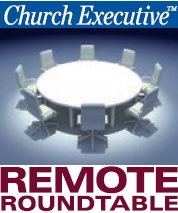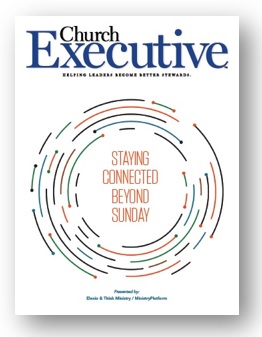 Tried-and-true strategies — plus, how technology can come alongside your best efforts
Tried-and-true strategies — plus, how technology can come alongside your best efforts
With regards to technology, what are the most crucial elements in a “recipe” that best positions a church to keep connected to its members all week long?

CEO
Think Ministry / MinistryPlatform
Chris Kehayias: The point of staying connected, and to “do church” in the first place, is to introduce people to Jesus and teach them to be his disciples. So, the best ingredients will do that in a way that’s accessible, digestible and tastes yummy.
Accessible and digestible: those are fairly standard issue. But if something doesn’t taste yummy, no one’s going to bite. And people’s tastes vary! You have to get to know the individuals you want to connect with — their interests and life stages. Find out what makes them tick and how you can help them grow, and they’ll engage because now you’re speaking to them.
As churches grow, that’s near impossible without some kind of system that collects this “data” and returns a comprehensive picture that can equip you to meet people where they are in their spiritual walk and engagement with your church. For most churches, this is the Church Management System (ChMS).

Client Service Director
Elexio
Tom Kline: Successful churches think like Jethro. Shortly after Moses leads the people out of Egypt, he’s inundated by the needs of all the people. Lines are wrapping around his tent from morning to evening. His father-in-law, Jethro, urges: This is no way to go about it. You’ll burn out, and so will all the people right along with you.
That sounds like a lot of church leaders; they’re wearing multiple hats. Jethro tells Moses to select capable leaders and appoint them as officials over smaller groups. If you work this way, you’ll have the strength to do whatever God commands you, and the people will flourish, too.
In terms of technology, successful churches use technology to delegate and empower key leaders and volunteers to take ownership of critical weekly connection points.
Websites
For the purpose of keeping members engaged all week long, which mistakes or oversights do you observe most often among church websites?
Kline: Simply letting content get stale and not planning in advance. A well-planned content calendar keeps website content timely.
Kehayias: You want to equip people to put their faith in action, but many websites fail to provide clear, if any, next steps.
We also see many churches employ multiple systems to receive data, but those systems don’t talk to each other, leaving the church with puzzle pieces that will never be fit together to show the big picture.
What are some best practices for mobilizing a church website to stay connected with members all week long?
Kehayias: Remember that whole “accessible and digestible” bit I mentioned earlier? Yeah, that!
Get mobile — People carry tons of sites and apps around with them all day, every day. Be one of them. Is your site mobile-responsive? Mobile-optimized? In this day and age, you can’t afford not to be.
Now what? — When someone searches for a group, give them an action step: sign up for the group, ask the leader a question. Oh, and these “action steps” are measurable.

Be intentional — Use tools that tell you what pages people spend time on, where they click, and how they interact. Then, use that to help you craft future messaging and next steps. It all comes back to getting a clear picture of your people, so you can speak their language and help them to engage.
Kline: Social, social, social. Kids to grandparents are spending hours scrolling through social media feeds. As a church, you’ve got to cast your lure where the fish are biting. Post memorable moments from Sunday, teasers for upcoming events — things that keep people engaged in church life.
This is an opportunity to think like Jethro. Get a few people from your congregation to help generate engaging content — maybe just something they found humorous during the week.
Especially for pastors, authenticity is key. People need to know you’re real, not just a figurehead.
Digital giving platforms
A church’s digital giving platforms might not spring to mind as a resource when it comes to staying connected with members all week long. But are there ways in which giving tools can be mobilized to this end?
Kline: I always urge churches to focus on what gifts do. Promote causes and impact stories. Then, link those to giving. A church we work with has a tagline that I love: “You don’t give to a church; you give through a church.”
I also recommend creating a forum, or an online form, where people can share their impact stories — maybe even connected to the giving function. It provides a constant pipeline of impact stories.
Kehayias: Absolutely! People want to make a difference. They want to impact others and be a part of life change. Show them how their giving can do that through videos or pictures. Show real lives that are being transformed by their dollars and they’ll keep coming back for more.
And, um, again: measurable. And I’m not just talking numbers measurable. I’m talking spiritual-health-of-a-heart kind of measurable.
Mobile apps
Obviously, a church app is a powerful tool for staying connected to members during the week. However, many churches leaders are intimidated at the prospect of developing an app. What’s the reality? What does the app development process actually look like?
Kehayias: Here’s what you do: Find a vendor or an app platform that’s all over the engagement tracking and ChMS integration scene. The deeper the integration, the better. Why? When someone registers for an event in your app, that registration should land right into your central system, attached to the individual’s record, further enhancing your picture of them, so you know who they are and can help them figure out their best spiritual next step.
Kline: Mobile apps have become plug-and-play. Essentially, you’ll go to a webpage that manages your app, select the features you want to turn on or off, add your content, and then click a button to publish. Then, there might be code to embed on your website that links to your app in the app store.
You can take your app a step further by integrating it with your ChMS, website and live streaming provider. Upload the Sunday sermon to Vimeo, to YouTube — it should be right in your mobile app.
Once that process is ‘demystified,’ in what ways can a church app help churches stay connected with members all week long? What strategies and practices have proven particularly effective, in your experience?
Kline: Make it easy for church members to connect with their small groups or even with individuals in the church by offering contact information, or a church directory, right in the app.
Kehayias: You’ve got an app integrated with your ChMS. And you’re capturing data to tell a story of who your people are. Great! Now, as you get to know them better, you can push events or groups or messaging that is tailored to what you know about them, which will be more suited to their tastes, and then they’re more likely to engage.
And speaking of engage, don’t just get your sermon out there. Provide supplemental resources, suggested reading, or daily “faith in action” steps to take.
Pro tip: Turn your readers into doers, by giving them fun ways to “level up” by rewarding streaks (taking certain actions every day) or displaying a progress bar for Bible studies or devotionals.
General
How do the stay-connected strategies discussed differ from visitors, to new members, to established members?
Kehayias: Visitors will never get involved if they don’t come back. I know — shocker, right? Find ways to be welcoming and highlight why they should return. Maybe invite them to a Meet ‘n Greet or provide free childcare for date nights.
New members might be more responsive to joining small groups or recurring volunteer opportunities. Dangle mission trips in front of them; that’ll really expedite a growth spurt.
Established members? They might be interested in taking steps toward leadership. Or running new guest orientation. (And those old-timers could always use a refresher on the simple things.)
Kline: I put the most emphasis on visitors. A lot of them don’t know anyone, so you must create as many active and passive touch points as possible. Thank them for coming, and invite them back.
This is where church technology saves you time with automated emails and text messages. You can also auto-assign tasks to volunteers so they can follow up with a newcomer whose interests they share.
Continue reaching out to visitors that way for a few weeks. Hopefully, your technology can recognize if a person has responded or if they should be pulled off the list.
How can the strategies discussed be made as personal as possible, although driven by technology?
Kline: Technology should foster human connection, not replace it.
Again, thinking like Jethro, churches should see technology as a tool to manage administration, automate processes and empower members. It’s those members and their empowerment that will help create vital connections outside the church, all week.
Kehayias: Each person is unique in their journey to become more like Christ. When you have a clear picture of your people, you can identify areas where they might need to grow. You become equipped to shepherd them. And you can present opportunities and encourage them in ways that make the most sense to them because you’re speaking their language. That will lead to higher engagement. Which can result in discipleship. And life change. And that’s the whole point, isn’t it?


